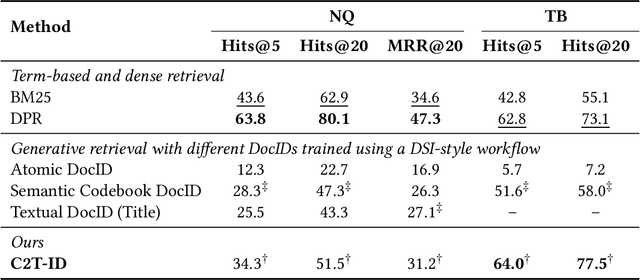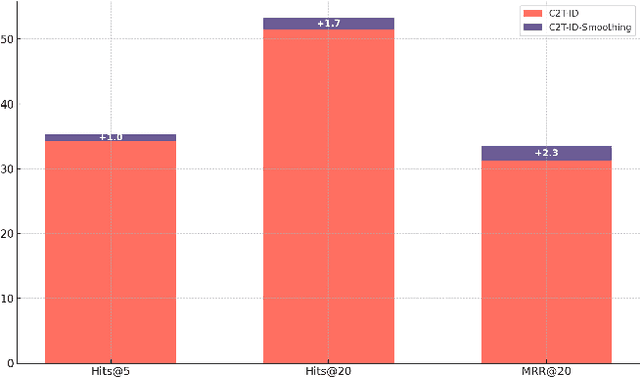Jiafeng Guo
StruProKGR: A Structural and Probabilistic Framework for Sparse Knowledge Graph Reasoning
Dec 14, 2025Abstract:Sparse Knowledge Graphs (KGs) are commonly encountered in real-world applications, where knowledge is often incomplete or limited. Sparse KG reasoning, the task of inferring missing knowledge over sparse KGs, is inherently challenging due to the scarcity of knowledge and the difficulty of capturing relational patterns in sparse scenarios. Among all sparse KG reasoning methods, path-based ones have attracted plenty of attention due to their interpretability. Existing path-based methods typically rely on computationally intensive random walks to collect paths, producing paths of variable quality. Additionally, these methods fail to leverage the structured nature of graphs by treating paths independently. To address these shortcomings, we propose a Structural and Probabilistic framework named StruProKGR, tailored for efficient and interpretable reasoning on sparse KGs. StruProKGR utilizes a distance-guided path collection mechanism to significantly reduce computational costs while exploring more relevant paths. It further enhances the reasoning process by incorporating structural information through probabilistic path aggregation, which prioritizes paths that reinforce each other. Extensive experiments on five sparse KG reasoning benchmarks reveal that StruProKGR surpasses existing path-based methods in both effectiveness and efficiency, providing an effective, efficient, and interpretable solution for sparse KG reasoning.
RouteRAG: Efficient Retrieval-Augmented Generation from Text and Graph via Reinforcement Learning
Dec 10, 2025Abstract:Retrieval-Augmented Generation (RAG) integrates non-parametric knowledge into Large Language Models (LLMs), typically from unstructured texts and structured graphs. While recent progress has advanced text-based RAG to multi-turn reasoning through Reinforcement Learning (RL), extending these advances to hybrid retrieval introduces additional challenges. Existing graph-based or hybrid systems typically depend on fixed or handcrafted retrieval pipelines, lacking the ability to integrate supplementary evidence as reasoning unfolds. Besides, while graph evidence provides relational structures crucial for multi-hop reasoning, it is substantially more expensive to retrieve. To address these limitations, we introduce \model{}, an RL-based framework that enables LLMs to perform multi-turn and adaptive graph-text hybrid RAG. \model{} jointly optimizes the entire generation process via RL, allowing the model to learn when to reason, what to retrieve from either texts or graphs, and when to produce final answers, all within a unified generation policy. To guide this learning process, we design a two-stage training framework that accounts for both task outcome and retrieval efficiency, enabling the model to exploit hybrid evidence while avoiding unnecessary retrieval overhead. Experimental results across five question answering benchmarks demonstrate that \model{} significantly outperforms existing RAG baselines, highlighting the benefits of end-to-end RL in supporting adaptive and efficient retrieval for complex reasoning.
Reward and Guidance through Rubrics: Promoting Exploration to Improve Multi-Domain Reasoning
Nov 18, 2025Abstract:Recent advances in reinforcement learning (RL) have significantly improved the complex reasoning capabilities of large language models (LLMs). Despite these successes, existing methods mainly focus on single-domain RL (e.g., mathematics) with verifiable rewards (RLVR), and their reliance on purely online RL frameworks restricts the exploration space, thereby limiting reasoning performance. In this paper, we address these limitations by leveraging rubrics to provide both fine-grained reward signals and offline guidance. We propose $\textbf{RGR-GRPO}$ (Reward and Guidance through Rubrics), a rubric-driven RL framework for multi-domain reasoning. RGR-GRPO enables LLMs to receive dense and informative rewards while exploring a larger solution space during GRPO training. Extensive experiments across 14 benchmarks spanning multiple domains demonstrate that RGR-GRPO consistently outperforms RL methods that rely solely on alternative reward schemes or offline guidance. Compared with verifiable online RL baseline, RGR-GRPO achieves average improvements of +7.0%, +5.4%, +8.4%, and +6.6% on mathematics, physics, chemistry, and general reasoning tasks, respectively. Notably, RGR-GRPO maintains stable entropy fluctuations during off-policy training and achieves superior pass@k performance, reflecting sustained exploration and effective breakthrough beyond existing performance bottlenecks.
Thinking Forward and Backward: Multi-Objective Reinforcement Learning for Retrieval-Augmented Reasoning
Nov 13, 2025Abstract:Retrieval-augmented generation (RAG) has proven to be effective in mitigating hallucinations in large language models, yet its effectiveness remains limited in complex, multi-step reasoning scenarios. Recent efforts have incorporated search-based interactions into RAG, enabling iterative reasoning with real-time retrieval. Most approaches rely on outcome-based supervision, offering no explicit guidance for intermediate steps. This often leads to reward hacking and degraded response quality. We propose Bi-RAR, a novel retrieval-augmented reasoning framework that evaluates each intermediate step jointly in both forward and backward directions. To assess the information completeness of each step, we introduce a bidirectional information distance grounded in Kolmogorov complexity, approximated via language model generation probabilities. This quantification measures both how far the current reasoning is from the answer and how well it addresses the question. To optimize reasoning under these bidirectional signals, we adopt a multi-objective reinforcement learning framework with a cascading reward structure that emphasizes early trajectory alignment. Empirical results on seven question answering benchmarks demonstrate that Bi-RAR surpasses previous methods and enables efficient interaction and reasoning with the search engine during training and inference.
Compression then Matching: An Efficient Pre-training Paradigm for Multimodal Embedding
Nov 11, 2025Abstract:Vision-language models advance multimodal representation learning by acquiring transferable semantic embeddings, thereby substantially enhancing performance across a range of vision-language tasks, including cross-modal retrieval, clustering, and classification. An effective embedding is expected to comprehensively preserve the semantic content of the input while simultaneously emphasizing features that are discriminative for downstream tasks. Recent approaches demonstrate that VLMs can be adapted into competitive embedding models via large-scale contrastive learning, enabling the simultaneous optimization of two complementary objectives. We argue that the two aforementioned objectives can be decoupled: a comprehensive understanding of the input facilitates the embedding model in achieving superior performance in downstream tasks via contrastive learning. In this paper, we propose CoMa, a compressed pre-training phase, which serves as a warm-up stage for contrastive learning. Experiments demonstrate that with only a small amount of pre-training data, we can transform a VLM into a competitive embedding model. CoMa achieves new state-of-the-art results among VLMs of comparable size on the MMEB, realizing optimization in both efficiency and effectiveness.
Can LLM Annotations Replace User Clicks for Learning to Rank?
Nov 10, 2025Abstract:Large-scale supervised data is essential for training modern ranking models, but obtaining high-quality human annotations is costly. Click data has been widely used as a low-cost alternative, and with recent advances in large language models (LLMs), LLM-based relevance annotation has emerged as another promising annotation. This paper investigates whether LLM annotations can replace click data for learning to rank (LTR) by conducting a comprehensive comparison across multiple dimensions. Experiments on both a public dataset, TianGong-ST, and an industrial dataset, Baidu-Click, show that click-supervised models perform better on high-frequency queries, while LLM annotation-supervised models are more effective on medium- and low-frequency queries. Further analysis shows that click-supervised models are better at capturing document-level signals such as authority or quality, while LLM annotation-supervised models are more effective at modeling semantic matching between queries and documents and at distinguishing relevant from non-relevant documents. Motivated by these observations, we explore two training strategies -- data scheduling and frequency-aware multi-objective learning -- that integrate both supervision signals. Both approaches enhance ranking performance across queries at all frequency levels, with the latter being more effective. Our code is available at https://github.com/Trustworthy-Information-Access/LLMAnn_Click.
C2T-ID: Converting Semantic Codebooks to Textual Document Identifiers for Generative Search
Oct 22, 2025



Abstract:Designing document identifiers (docids) that carry rich semantic information while maintaining tractable search spaces is a important challenge in generative retrieval (GR). Popular codebook methods address this by building a hierarchical semantic tree and constraining generation to its child nodes, yet their numeric identifiers cannot leverage the large language model's pretrained natural language understanding. Conversely, using text as docid provides more semantic expressivity but inflates the decoding space, making the system brittle to early-step errors. To resolve this trade-off, we propose C2T-ID: (i) first construct semantic numerical docid via hierarchical clustering; (ii) then extract high-frequency metadata keywords and iteratively replace each numeric label with its cluster's top-K keywords; and (iii) an optional two-level semantic smoothing step further enhances the fluency of C2T-ID. Experiments on Natural Questions and Taobao's product search demonstrate that C2T-ID significantly outperforms atomic, semantic codebook, and pure-text docid baselines, demonstrating its effectiveness in balancing semantic expressiveness with search space constraints.
A Survey of Vibe Coding with Large Language Models
Oct 14, 2025Abstract:The advancement of large language models (LLMs) has catalyzed a paradigm shift from code generation assistance to autonomous coding agents, enabling a novel development methodology termed "Vibe Coding" where developers validate AI-generated implementations through outcome observation rather than line-by-line code comprehension. Despite its transformative potential, the effectiveness of this emergent paradigm remains under-explored, with empirical evidence revealing unexpected productivity losses and fundamental challenges in human-AI collaboration. To address this gap, this survey provides the first comprehensive and systematic review of Vibe Coding with large language models, establishing both theoretical foundations and practical frameworks for this transformative development approach. Drawing from systematic analysis of over 1000 research papers, we survey the entire vibe coding ecosystem, examining critical infrastructure components including LLMs for coding, LLM-based coding agent, development environment of coding agent, and feedback mechanisms. We first introduce Vibe Coding as a formal discipline by formalizing it through a Constrained Markov Decision Process that captures the dynamic triadic relationship among human developers, software projects, and coding agents. Building upon this theoretical foundation, we then synthesize existing practices into five distinct development models: Unconstrained Automation, Iterative Conversational Collaboration, Planning-Driven, Test-Driven, and Context-Enhanced Models, thus providing the first comprehensive taxonomy in this domain. Critically, our analysis reveals that successful Vibe Coding depends not merely on agent capabilities but on systematic context engineering, well-established development environments, and human-agent collaborative development models.
Does Generative Retrieval Overcome the Limitations of Dense Retrieval?
Sep 26, 2025Abstract:Generative retrieval (GR) has emerged as a new paradigm in neural information retrieval, offering an alternative to dense retrieval (DR) by directly generating identifiers of relevant documents. In this paper, we theoretically and empirically investigate how GR fundamentally diverges from DR in both learning objectives and representational capacity. GR performs globally normalized maximum-likelihood optimization and encodes corpus and relevance information directly in the model parameters, whereas DR adopts locally normalized objectives and represents the corpus with external embeddings before computing similarity via a bilinear interaction. Our analysis suggests that, under scaling, GR can overcome the inherent limitations of DR, yielding two major benefits. First, with larger corpora, GR avoids the sharp performance degradation caused by the optimization drift induced by DR's local normalization. Second, with larger models, GR's representational capacity scales with parameter size, unconstrained by the global low-rank structure that limits DR. We validate these theoretical insights through controlled experiments on the Natural Questions and MS MARCO datasets, across varying negative sampling strategies, embedding dimensions, and model scales. But despite its theoretical advantages, GR does not universally outperform DR in practice. We outline directions to bridge the gap between GR's theoretical potential and practical performance, providing guidance for future research in scalable and robust generative retrieval.
How Do LLM-Generated Texts Impact Term-Based Retrieval Models?
Aug 25, 2025



Abstract:As more content generated by large language models (LLMs) floods into the Internet, information retrieval (IR) systems now face the challenge of distinguishing and handling a blend of human-authored and machine-generated texts. Recent studies suggest that neural retrievers may exhibit a preferential inclination toward LLM-generated content, while classic term-based retrievers like BM25 tend to favor human-written documents. This paper investigates the influence of LLM-generated content on term-based retrieval models, which are valued for their efficiency and robust generalization across domains. Our linguistic analysis reveals that LLM-generated texts exhibit smoother high-frequency and steeper low-frequency Zipf slopes, higher term specificity, and greater document-level diversity. These traits are aligned with LLMs being trained to optimize reader experience through diverse and precise expressions. Our study further explores whether term-based retrieval models demonstrate source bias, concluding that these models prioritize documents whose term distributions closely correspond to those of the queries, rather than displaying an inherent source bias. This work provides a foundation for understanding and addressing potential biases in term-based IR systems managing mixed-source content.
 Add to Chrome
Add to Chrome Add to Firefox
Add to Firefox Add to Edge
Add to Edge